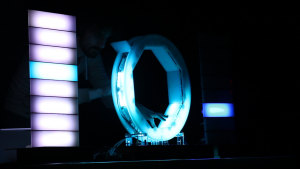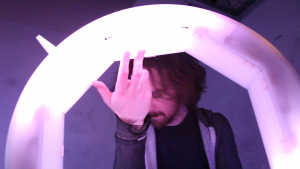Clicking the top and bottom grey bars changes the amount of lines and position of the lines.
Clicking the canvas flips the colours of the two different sets of lines.
Moving from quadrant to quadrant changes the line weights.
sketch
/*
Jamie Ho
jamieh@andrew.cmu.edu
10:30
Project 4
*/
var ratio;
var centreX;
var centreY;
var lines;
var t;
function setup() {
createCanvas(400, 300);
ratio = 30; //changes position of control points
centreX = width/2;
centreY = height/2;
lines = 10; //changes how how many divisions there are on the curve
//which generates the white and blue lines
}
function draw() {
background(0);
for (var i = 0; i <= lines; i++) {
t = i / lines;
//curve 1 from top L corner to mouse
c1x = curvePoint(mouseX, 0, mouseX, width/ratio*2, t);
c1y = curvePoint(mouseY, 0, mouseY, height/ratio*6, t);
//curve 2 from bottom L corner to mouse
c2x = curvePoint(mouseX, 0, width/ratio*6, width, t);
c2y = curvePoint(mouseY, height, mouseY, height/ratio*2, t);
//curve 3 from top R corner to mouse
c3x = curvePoint(width/ratio*2, width, mouseX, mouseX, t);
c3y = curvePoint(mouseY, 0, height/ratio*2, mouseY, t);
//curve 4 from bottom R corner to mouse
c4x = curvePoint(mouseX, width, width/ratio*6, 0, t);
c4y = curvePoint(mouseY, height, mouseY, height/ratio*6, t);
strokeWeight(1);
if(mouseX < centreX & mouseY < centreY){ //top L
strokeWeight(0.15);
} else if(mouseX > centreX & mouseY < centreY){ //top R
strokeWeight(0.60);
} else if(mouseX < centreX & mouseY > centreY){ //bottom L
strokeWeight(0.30);
} else { //bottom R
strokeWeight(0.90);
}
if(mouseIsPressed){
//white lines become blue
stroke(204, 230, 255);
line(c1x, c1y, c2x, c2y);
line(c1x, c1y, c3x, c3y);
line(c1x, c1y, c4x, c4y);
line(c2x, c2y, c1x, c1y);
line(c2x, c2y, c3x, c3y);
line(c2x, c2y, c4x, c4y);
line(c3x, c3y, c1x, c1y);
line(c3x, c3y, c2x, c2y);
line(c3x, c3y, c4x, c4y);
//blue lines become white
stroke("WHITE");
line(c1x, c1y, c4y, c4x);
line(c2x, c2y, c1y, c1x);
line(c3x, c3y, c2y, c2x);
line(c4x, c4y, c3y, c3x);
} else{
//lines have different grey scales
stroke(75);
line(c1x, c1y, c2x, c2y);
line(c1x, c1y, c3x, c3y);
line(c1x, c1y, c4x, c4y);
stroke(150);
line(c2x, c2y, c1x, c1y);
line(c2x, c2y, c3x, c3y);
line(c2x, c2y, c4x, c4y);
stroke(255);
line(c3x, c3y, c1x, c1y);
line(c3x, c3y, c2x, c2y);
line(c3x, c3y, c4x, c4y);
//blue lines
stroke(0, 119, 230);
line(c1x, c1y, c2y, c2x);
line(c2x, c2y, c3y, c3x);
line(c3x, c3y, c4y, c4x);
line(c4x, c4y, c1y, c1x);
}
}
//the four rectangles here are for ease of seeing where to mouse click
noStroke();
fill(200, 200);
rect(0, 0, width/2, 20);
rect(0, height-20, width/2, 20);
fill(200, 100);
rect(width/2, 0, width, 20);
rect(width/2, height-20, width, 20);
stroke("RED");
strokeWeight(1);
//Up arrow
line(width/4, 0, width/4, 20);
line(width/4-10, 10, width/4, 0);
line(width/4+10, 10, width/4, 0);
//Right arrow
line(width/4*3-10, 10, width/4*3+10, 10);
line(width/4*3, 0, width/4*3+10, 10);
line(width/4*3+10, 10, width/4*3, 20);
if(mouseIsPressed & mouseY < 20 && mouseX < width/2 && lines < 60){ //if click on top L bar
lines += 1; //amt of lines increases to 59
} else if(mouseIsPressed & mouseY > 280 && mouseX < width/2 && lines > 1){ //if click on bottom L bar
lines -= 1; //amt of lines decreases to 1
}
if(mouseIsPressed & mouseY < 20 && mouseX > width/2){ //if click on top R bar
ratio -= 1; //lines shift right
} else if(mouseIsPressed & mouseY > 280 && mouseX > width/2){ //if click on bottom R bar
ratio += 1; //lines shift left
}
}
The hardest part was trying not to repeat code, which I had trouble with in the for loop to achieve the effect of what happens when mouse is pressed.
![[OLD FALL 2017] 15-104 • Introduction to Computing for Creative Practice](../../../../wp-content/uploads/2020/08/stop-banner.png)



